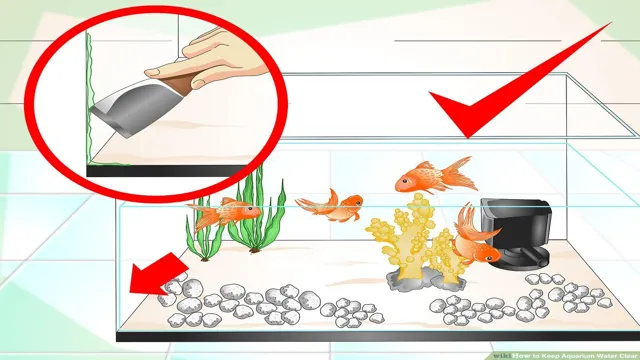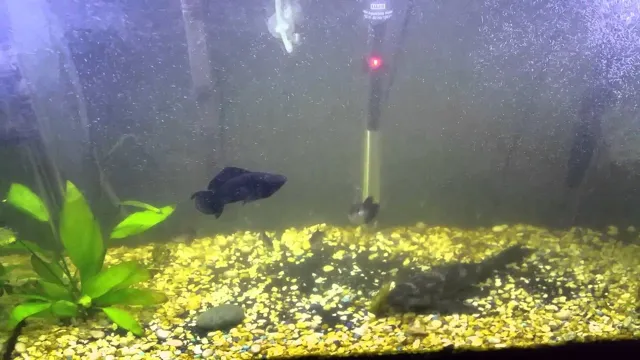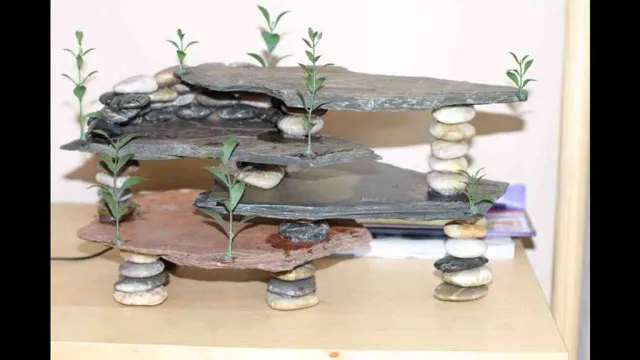How to Keep Water in Aquarium Clear: Top Tips for Crystal Clear Tank Maintenance

Maintaining crystal clear water in your aquarium is essential for the health and survival of your aquatic pets. However, keeping your aquarium water crystal clear can be quite a challenge and requires consistent effort and attention. In this blog post, we will explore the most effective and practical tips to help you keep your aquarium water clear and healthy.
From choosing the right filtration system to regular water changes, we will cover everything you need to know to keep your aquarium water clear and your fish happy. So, let’s dive in and explore the secrets to keeping your aquarium water crystal clear!
Understanding the causes of cloudy water
If you’re wondering how to keep water in your aquarium clear, one of the most important factors to consider is the causes of cloudy water. These can include overfeeding your fish, not changing the water frequently enough, having too many fish in the tank, and not properly maintaining the filter. Overfeeding can lead to excess waste and uneaten food, while not changing the water can result in a buildup of toxins.
Having too many fish in the tank can also lead to increased waste production and decreased oxygen levels. Keeping up with filter maintenance is crucial to ensure it’s functioning properly and removing impurities from the water. By understanding these causes and taking preventative measures, you can maintain clear water in your aquarium and provide a healthy environment for your fish to thrive in.
Overfeeding
Overfeeding can cause a lot of issues in your aquarium, and one of the most common is cloudy water. It occurs when water becomes hazy, making it difficult to see your fish or plants. Overfeeding can lead to cloudiness by introducing excess nutrients that bacteria love to consume, leading to bacterial bloom.
Additionally, uneaten food particles that remain in your aquarium can also contribute to the issue. This can be prevented by only feeding your fish what they need to consume without overfeeding them. By doing so, you will help maintain a healthier and cleaner environment for your aquarium inhabitants.
It is essential to monitor the amount of food you add to the tank and always remove any leftovers to prevent overfeeding. Remember, preventing overfeeding in your tank will not only result in better water quality, but also happier and healthier fish.

Overstocking
Overstocking can be a major culprit when it comes to cloudy aquarium water. Adding too many fish or other aquatic animals to your tank can cause an imbalance in the ecosystem, leading to excessive waste and leftover food that can cloud the water. When there are too many organisms in a limited space, they become stressed and more susceptible to illness, which can also contribute to a cloudy appearance.
It’s important to research the appropriate stocking levels for your tank and to monitor the water quality regularly to ensure a healthy environment for your aquatic pets. By maintaining a balanced ecosystem, you can help prevent cloudy water and ensure a thriving aquarium.
Poor filtration
Cloudy water can be a frustrating and unappealing problem for pool owners. Poor filtration is one of the main causes of cloudy water. Your filtration system is responsible for removing debris, dirt, and other contaminants from your pool water.
If your filtration system is not working properly, impurities will build up and cause cloudy water. There are several things that can cause poor filtration, including clogged filters, an underpowered pump, or an aging filtration system. To ensure that your filtration system is working as it should, make sure to maintain it regularly by replacing filters and checking the pump’s flow rate.
With a little bit of effort and attention, you can keep your pool water clear and inviting all season long.
Irregular water changes
If you’re noticing cloudy water in your fish tank, it could be a sign of irregular water changes. It’s important to understand what’s causing the cloudiness, as it can impact the health and well-being of your fish. One cause could be overfeeding, which leads to excess waste and uneaten food particles accumulating in the tank.
Another possible culprit is a bacterial or algae bloom, which can occur if the water chemistry is imbalanced. Avoiding irregular water changes and incorporating regular maintenance can help prevent these issues. Ensuring that you’re properly cleaning and filtering your tank can also make a big difference.
Don’t let cloudiness go unchecked – take action before it becomes a bigger problem for your aquatic pets.
Choosing the right filter
If you want to keep your aquarium water crystal clear, choosing the right filter is key. There are a variety of filters on the market, each with their own advantages and disadvantages. One of the most popular types of filters is the power filter, which uses a motor to circulate water through a filter cartridge.
Another option is a canister filter, which can hold more filter media and is especially useful for larger tanks. Hang-on-back filters are also popular and are easy to install. No matter which filter you choose, make sure to regularly clean or replace the filter media to ensure its effectiveness.
By selecting the right filter and maintaining it properly, you can keep your aquarium water clear and your fish happy and healthy.
Type of filter
When it comes to choosing the right filter, it’s essential to consider the purpose you want it to serve. Different types of filters cater to various requirements, such as improving air quality, purifying water, or extracting dust and debris. For instance, air filters can eliminate harmful pollutants and allergens that can cause respiratory problems.
Likewise, water filters can remove contaminants that affect water taste and quality, making it safer to drink. Some filters use carbon filters, while others use reverse osmosis to remove impurities. Choosing the right filter also depends on your budget and the maintenance requirements.
You may need to replace or clean some filters periodically to ensure optimal performance. In conclusion, selecting the right filter depends on the intended use, and it’s essential to do research to ensure you make an informed decision.
Proper sizing
When it comes to choosing the right filter for your home or business, proper sizing is key. You don’t want a filter that’s too small and can’t handle the amount of air flowing through your HVAC system, nor do you want a filter that’s too large and causing your system to work harder than necessary. This is where understanding MERV ratings and air flow come into play.
A MERV rating determines the size of particles a filter can capture, but it’s also important to note the higher the MERV rating, the more air flow resistance it may create. Finding the right balance between MERV rating and air flow is crucial for optimal efficiency and air quality. You can consult with a professional or HVAC technician to determine the right filter size and MERV rating for your specific system.
Investing in a properly sized filter may seem small, but it makes a big difference in the long run.
Maintenance
When it comes to maintaining your filtration system, choosing the right filter is crucial. With so many different types of filters available, it can be overwhelming to know which one is best for your needs. The key is to consider your specific requirements and the type of contaminants you need to remove.
For example, if you have a pool, you’ll need a different filter than if you have a fish tank. The most important thing is to make sure you choose a filter that is properly sized for your application. Remember, a filter that is too small won’t be able to effectively remove all the contaminants, while a filter that is too large will be inefficient and costly to operate.
By taking the time to choose the right filter, you’ll ensure that your filtration system operates at peak efficiency, providing you with clean and clear water.
Maintaining a healthy environment
Maintaining a healthy environment in your aquarium is crucial for the well-being of your fish. One of the most common issues that aquarium owners face is cloudy or murky water, which can harm your fish and negatively impact the aesthetic of your tank. To keep water in your aquarium clear, there are several steps that you can take.
Firstly, you need to ensure that you are not overfeeding your fish, as excess food can lead to a buildup of waste in the water. Secondly, you can use a good quality filter to remove any debris, excess food, and waste from the water. Additionally, regular water changes can help to keep the water clean and clear.
Finally, you can add live plants to your aquarium, which can help to absorb excess nutrients and produce oxygen, resulting in clear water. By following these simple steps, you can ensure that your fish enjoy a healthy and clear environment in their aquarium.
Regular water changes
One of the most important things you can do to maintain a healthy environment for your aquatic pets is to perform regular water changes. This simple yet crucial task helps to remove built-up waste, debris, and toxins that can negatively impact the water quality in your aquarium. Additionally, water changes can replenish trace elements and nutrients that are essential for the well-being of your fish, plants, and other aquatic inhabitants.
But how often should you change the water? Well, the general rule of thumb is to change out 10-20% of the water in your aquarium every one to two weeks. Of course, this can vary depending on factors such as the size of the aquarium, the number of fish, and the type of filtration system you are using. So, be sure to do a little research or consult with a professional to determine what is best for your particular set-up.
By performing regular water changes, you’ll be helping to keep your aquatic pets happy and healthy, which will ultimately lead to a more vibrant and enjoyable aquarium experience.
Clean the tank and filter
Maintaining a healthy environment for your fish is crucial to their health and longevity. One important aspect of aquarium maintenance is cleaning the tank and filter regularly. Over time, debris and waste can accumulate in the tank and filter, leading to poor water quality and potentially harmful conditions for your fish.
To prevent this, it’s important to establish a routine cleaning schedule that includes removing any uneaten food, dead plants, and excess waste from the tank. Additionally, you should clean the filter every 2-4 weeks, depending on the size of your tank and the number of fish in it. This can be done by removing the filter media, rinsing it with clean water, and replacing any worn or damaged parts.
By taking these simple steps, you can help ensure that your fish have a clean and healthy environment in which to thrive. So be sure to make tank and filter cleaning an essential part of your maintenance routine to keep your fish happy and healthy.
Proper feeding
Proper feeding is vital to keeping your pets healthy and happy, but it’s not the only factor to consider. Maintaining a healthy environment also plays a crucial role in your pet’s wellbeing. For example, keeping their living space clean and free of hazards can prevent accidents and sickness.
Regular cleaning of their belongings and bedding, as well as changing their water frequently, can help prevent the growth of harmful bacteria. Providing adequate space for your pet to move around and exercise can also promote physical and mental health. Additionally, keeping their living space at an appropriate temperature and humidity level can prevent respiratory issues and other health problems.
Ultimately, a healthy environment, combined with proper nutrition, can help ensure a longer and happier life for your furry friend.
Conclusion
In conclusion, keeping the water in your aquarium clear is more than just a matter of aesthetics. It’s about providing a healthy environment for your fish and other aquatic inhabitants. By regularly performing water changes, maintaining proper filtration, avoiding overfeeding, and keeping your hands out of the tank as much as possible, you can prevent the build-up of debris and ensure that your aquatic friends are swimming happily in a crystal-clear environment.
Remember, a clean tank is a happy tank, so keep calm and keep your water clear!”
FAQs
Why is my aquarium water always cloudy?
Cloudy water in aquariums is usually due to excess waste and bacteria buildup. To keep water in the aquarium clear, make sure to perform regular water changes and clean the filter regularly.
How often should I clean my aquarium filter?
It is recommended to clean your aquarium filter once every two weeks to keep the water clean and clear.
Can adding live plants help clear aquarium water?
Yes, live aquarium plants can help keep the water clear by removing excess nutrients and waste from the water.
What type of fish are best for keeping aquarium water clear?
Certain species of fish, such as the Siamese algae eater and certain types of catfish, are known to help keep aquarium water clear by eating algae and other waste.
How can overfeeding affect aquarium water clarity?
Overfeeding can lead to excess waste buildup and bacterial growth, which can result in cloudy water. Make sure to feed your fish only the amount they need, and clean any uneaten food from the tank.
Can using tap water affect aquarium water clarity?
Yes, tap water can contain chemicals and additives that can lead to cloudy water. It is recommended to use a water conditioner before adding tap water to the aquarium.
What can I do if my aquarium water is still cloudy even after regular maintenance?
If regular maintenance does not keep the water clear, consider using a water clarifier or seeking advice from a professional aquarium specialist.






